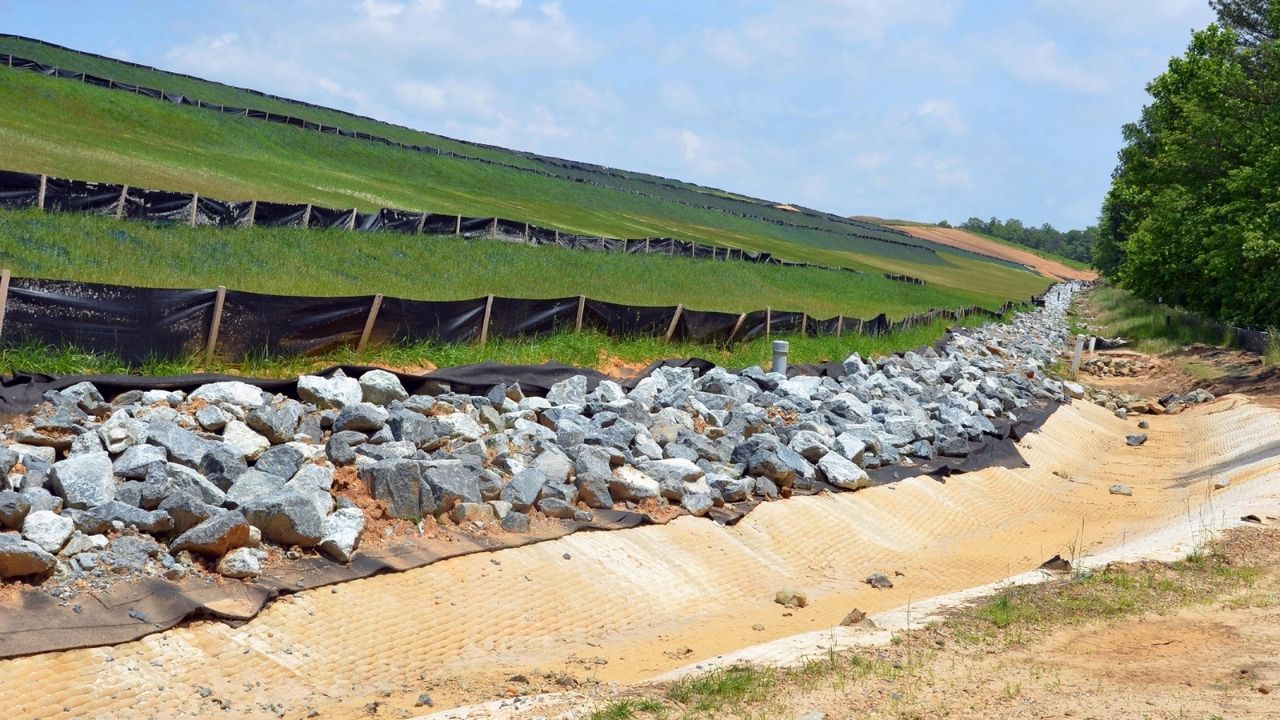
Erosion control is vital for maintaining healthy landscapes and preventing soil loss. Erosion happens when wind, water, or other natural forces wear away soil and rock. This can lead to problems like reduced agricultural productivity, water pollution, and damaged ecosystems. Erosion control methods help protect the environment and ensure sustainable land use. These techniques include planting vegetation, using mulch, building terraces, and installing barriers like silt fences. Understanding the importance of erosion control can help communities and individuals take action to preserve their land. Let's dive into 27 interesting facts about erosion control that highlight its significance and various methods.
Key Takeaways:
- Erosion control is crucial for protecting soil and landscapes from damage caused by water, wind, and human activity. Techniques like terracing and mulching help prevent soil loss and maintain fertile land.
- Ancient civilizations used erosion control methods, and modern techniques like no-till farming and permeable pavements continue to protect soil and water quality. Community involvement and innovative solutions play a key role in preserving the environment.
Understanding Erosion Control
Erosion control is vital for maintaining healthy landscapes and preventing soil loss. Here are some fascinating facts about erosion control that highlight its importance and methods.
-
Erosion Control Definition: Erosion control refers to practices used to prevent soil erosion, which is the displacement of the upper layer of soil due to water, wind, or human activity.
-
Historical Use: Ancient civilizations like the Romans and Egyptians used erosion control techniques such as terracing and crop rotation to maintain fertile land.
-
Soil Erosion Impact: Soil erosion can lead to loss of fertile land, reduced agricultural productivity, and increased pollution in waterways.
-
Natural Barriers: Plants and trees act as natural barriers against erosion by stabilizing the soil with their root systems.
Techniques for Erosion Control
Various methods are employed to control erosion, each suited to different environments and needs.
-
Terracing: This involves creating stepped levels on a slope to reduce water runoff and soil erosion.
-
Mulching: Applying a layer of mulch on the soil surface helps retain moisture and protect against erosion.
-
Contour Plowing: Plowing along the contour lines of a slope reduces water runoff and soil erosion.
-
Riprap: Placing rocks or other materials along shorelines or slopes to prevent erosion caused by water flow.
Erosion Control in Agriculture
Agricultural practices play a significant role in controlling soil erosion and maintaining soil health.
-
Cover Crops: Planting cover crops like clover or rye helps protect the soil from erosion during off-seasons.
-
Crop Rotation: Alternating crops in a field can improve soil structure and reduce erosion.
-
No-Till Farming: This method minimizes soil disturbance, reducing erosion and improving soil health.
-
Grassed Waterways: Planting grass in natural drainage areas helps slow water flow and reduce erosion.
Erosion Control in Urban Areas
Urban environments also face erosion challenges, requiring specific strategies to manage soil displacement.
-
Silt Fences: Temporary barriers made of geotextile fabric help control sediment runoff from construction sites.
-
Retaining Walls: These structures hold back soil on steep slopes, preventing erosion and landslides.
-
Permeable Pavements: Pavements that allow water to pass through reduce runoff and erosion.
-
Green Roofs: Vegetated roofs help absorb rainwater, reducing runoff and erosion in urban areas.
Environmental and Economic Benefits
Erosion control offers numerous benefits beyond just preventing soil loss.
-
Water Quality Improvement: Reducing soil erosion helps prevent sediment and pollutants from entering water bodies.
-
Habitat Protection: Erosion control preserves habitats for plants and animals by maintaining stable soil conditions.
-
Cost Savings: Effective erosion control can reduce the need for costly repairs and maintenance of infrastructure.
-
Increased Agricultural Productivity: Preventing soil erosion maintains fertile land, leading to better crop yields.
Innovative Erosion Control Solutions
New technologies and methods continue to emerge, offering innovative solutions for erosion control.
-
Geotextiles: These synthetic fabrics are used to stabilize soil and prevent erosion in various applications.
-
Bioengineering: Combining biological and engineering techniques, such as using live plants and structural supports, to control erosion.
-
Hydroseeding: Spraying a mixture of seeds, mulch, and water onto the soil to promote vegetation growth and prevent erosion.
-
Erosion Control Blankets: These biodegradable blankets protect soil from erosion while promoting vegetation growth.
Community Involvement in Erosion Control
Community efforts can significantly impact erosion control and environmental conservation.
-
Volunteer Programs: Many communities organize volunteer programs to plant trees and vegetation in erosion-prone areas.
-
Educational Campaigns: Raising awareness about erosion control and sustainable practices helps communities take action.
-
Local Regulations: Implementing and enforcing local regulations on construction and land use can help reduce erosion.
Final Thoughts on Erosion Control
Erosion control is crucial for preserving landscapes and preventing environmental damage. By understanding the various methods, like planting vegetation, using geotextiles, and building terraces, we can effectively combat soil erosion. These techniques not only protect the land but also promote sustainable agriculture and prevent water pollution. Implementing erosion control measures can save money in the long run by reducing the need for costly repairs and maintenance. Whether you're a farmer, gardener, or property owner, taking steps to control erosion benefits everyone. Remember, small actions can make a big difference. So, next time you see bare soil, think about how you can help protect it. By working together, we can ensure healthier, more resilient landscapes for future generations.
Frequently Asked Questions
Was this page helpful?
Our commitment to delivering trustworthy and engaging content is at the heart of what we do. Each fact on our site is contributed by real users like you, bringing a wealth of diverse insights and information. To ensure the highest standards of accuracy and reliability, our dedicated editors meticulously review each submission. This process guarantees that the facts we share are not only fascinating but also credible. Trust in our commitment to quality and authenticity as you explore and learn with us.
